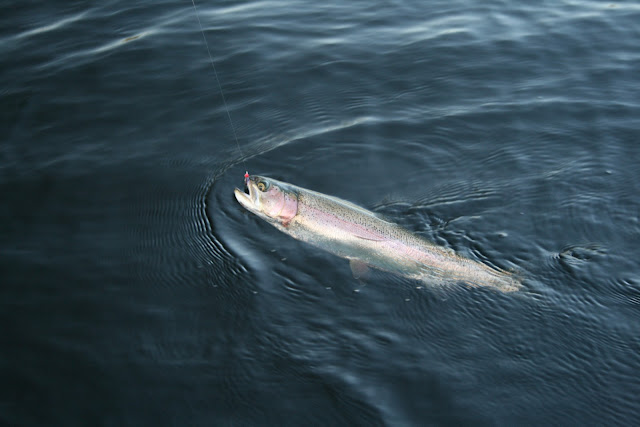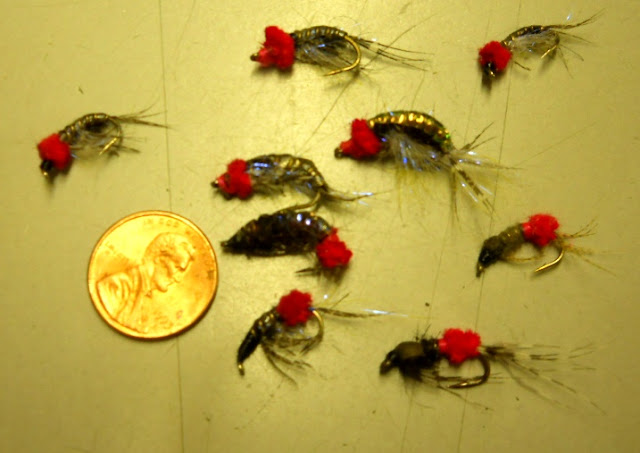I remember a trip earlier this summer to Quartz lake when the rainbows were trying to spawn on the sandy beach of the lake. I was up at 5:00 in the morning, at the beach alone and the fish were spawning in very shallow water with dorsal fins cutting the surface. Eagles were wading around in the shallow water catching and eating fish. I threw every fly I had at the rainbows with no luck. I tried my own patterns and standard patterns. I tried dry flies and wet flies, they would bite at nothing. I didn't have any egg patterns with me. The evening before, the fish were not visible but they were there, off shore, staging for the spawn. People were having some success fishing from shore with salmon row.
The Development of the Egg Butt Scud and cousins
The memory that morning at Quartz lake stays in my mind. I thought if I'd had a wet fly egg pattern I might have been able to get some rainbows to bite. There is a very popular Alaska dry fly pattern called the Salcha Pink, its very good for grayling on the surface. In my mind, I needed to put eggs under the water. There is also the very popular egg sucking leach, it's very effective for many species of Alaskan Salmonids. Our waters don't have any leaches to speak of except the egg sucking variety.
Scuds and nymphs are a very important food source for stocked rainbow, char and silvers in interior lakes, so I thought that a pattern that combines an important year-round food and salmon eggs might be effective. Scuds are fresh water shrimp, the ones in our lakes are black. The Egg Butt Scud may be just the thing to spark a bite from an otherwise inactive fish. Before Mike and I left for the lake I tied a few Egg Butt Scuds, Egg Head Scuds, some Egg Head Nymphs and Egg Butt Nymphs.
Some Egg Butt Scuds and shirt sleeve relatives ready for Birch lake.
When Mike and I got to the lake there were two boats leaving, they had both fished all day and between them caught two small char. Some people were fishing from the dock but they had also not caught anything. The outlook was bleak but we had two things going for us, we were arriving in the evening and the fishing should be better than during the heat of the day. We also had the Egg Butt Scud.
I didn't know how to fish the lake so I spent the first couple of hours rowing around trying to find some fish-able water. The lake bottom is almost pancake flat with shallows stretching out to quite a distance from shore. After a while we found a reasonable weed line with what seemed to be a good drop off. We anchored casting distance from the weed line and casted toward it. The fishing was not hot but when I did get a strike, it was explosive. The rainbow hit the fly from below, at almost the instant it hit the water. The fish cleared the water with the first hit and did it again several times during the fight. It was a pretty good tussle that I thoroughly enjoyed.
The first rainbow with the Egg Head Scud, the fight almost over.
A chunky fish, just over 19 inches and just under three pounds. You can tell this is a hatchery fish by the missing pectoral fins.
The holographic dubbing really sparkles blue when it's wet.
I am pretty pleased that I was able to catch a fish in a lake I had never fished when no-one else was catching fish.
Tying The Egg Head Scud
Materials
Hook No. 10 curved pupa hook
Thread 70 denier
Tail died mallard, wood duck or Guinea fowl chest feather
Body black rabbit
Rib copper or black wire
Back scud back film, mottled black
Legs mallard wood duck or Guinea fowl chest feather and holographic dubbing
Egg med. to small dark red chenille
The hook is dressed around the curve and four or five feather fibers are tied in for the tail.
A four inch piece of copper wire and the scud back film is tied in.
Next, spin on some black rabbit dubbing fur. Scud colors change from area to area so change your materials to match.
wrap the dubbing leaving about 1/3 of the hook shank free.
Turn the hook up-side-down, tie in the legs, in two places under the belly of the scud. I mixed the feather fibers and the holographic dubbing. It gives the scud an iridescent blue color.
Turn the scud back over, pull the scud back film over to cover the top of the body, tie it down at the end of the dubbing.
Wrap the copper wire around the body of the scud to form even segments. Use a dubbing needle to free leg fibers and dubbing from the wire as you wrap it. Tie it off and clip it.
Tie in the red chenille.
Form the egg with two wraps of the chenille, tie it down and clip it.
Whip finish the fly and cement the head.
Close cousin to the Egg Head Scud, the Egg Butt Scud is tied the same way as the egg headed relative, except the egg is tied in before the body. The nymphs are done the same way, just add an egg to your favorite nymph pattern, I tied some eggs in at the head and some at the butt.
Some Egg Heads and some Egg Butts with a penny for scale.
Mike and I are leaving on a float trip of the lower Gulkana in a couple of days, I plan to really give the Egg Butts and Egg Heads a work out on rainbows and grayling. I also tied some flies for reds and kings.

Red salmon flies.

King salmon flies.
We've been making our own fly boxes with old VCR tape cases and weather stripping, they work really well.
The really interesting thing about these interior Alaska lakes is how much these fresh water snails are used for food by large rainbows. The last two I kept both had stomachs and digestive tracts full of them. This is about one third of the snails I found in one trout. It may sound a little funny, but I think I will try a fly pattern that imitates this food source.
Stay tuned for news from the Gulkana and some Red salmon fly recipes.





















A fishing trip is a great way to escape the hustle and bustle of city life and get back to nature and discover what is really important in life.
ReplyDeleteAlaska Fresh Water Fishing